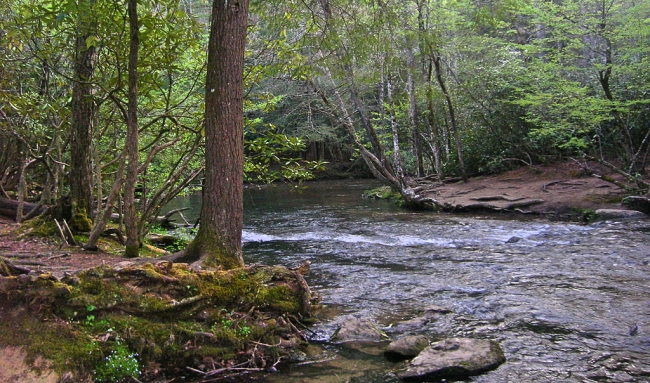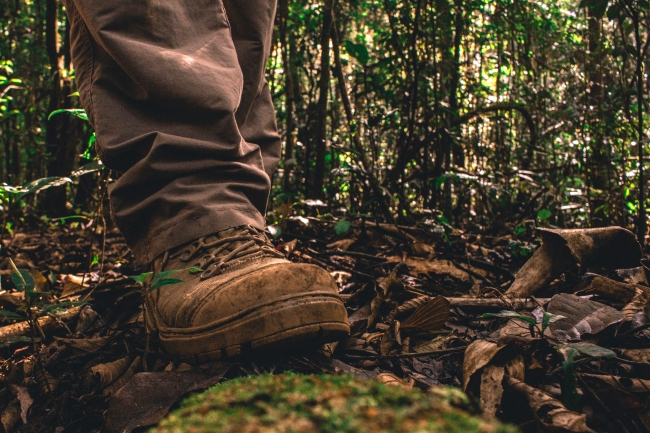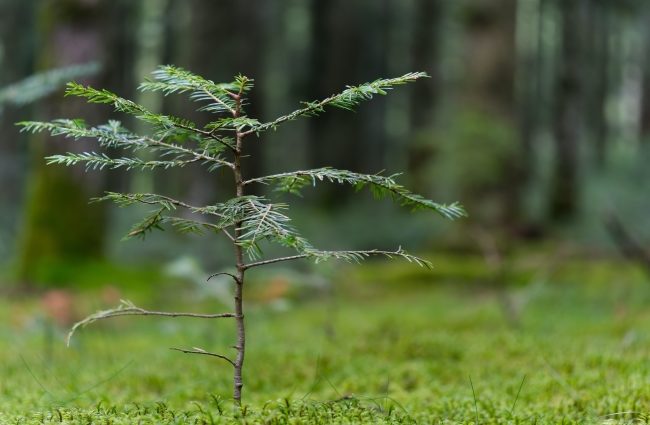We trundled down the thin gravelly road, Dad and I, in the rickety old pickup truck, green enough to blend with the forest, especially after one of those morning drizzles in late summer that just makes the trees look . . . alive, more alive than usual. The dew-glazed hemlock and rhododendron looked especially inviting on this particular morning.
I’d spent much of my previous 14 years in this pristine area of the Great Smoky Mountains, but this was our first time back by Abrams Creek, which runs along the western edge of the Smokies, since the great storm that ravaged the southern Appalachian a Spring prior. Officials and Facebook aficionados called it the “Super Outbreak” at the time, the largest such weather event ever recorded in the Southeast. But on this particular morning, one could hardly tell there had ever been in storm in this forest. The sun faintly shimmered through the sturdy, motionless trees, illuminating the path ahead with natural spotlights and beckoning us into the ethereal woodland.
We drove through the quiet campground, a quaint woody oasis in the misty midst of Appalachia, before parking the truck in front of a wide, rusted gate, beyond which winded a thinner dirt path. Dad’s green pickup might have been the only vehicle around for miles. We called the faithful truck Forrest, not just because of its camouflaged resemblance with the flourishing trees, but also because, as Dad put it: “He just keeps on runnin’.” I always liked that. It made Forrest invincible, self-sustaining, like the woods around us. No matter how much the pickup aged or how much damage it took on, it continued to function, to carry out its purpose – in a way, maybe even more suitably than before.

As I rode in the passenger side through verdant forest, I remembered a few days before, during a small thunderstorm that knocked down a few tree limbs by our house, when I asked Dad how forests could keep growing if hazards continued to cause trees to fall. He had explained to me the concept of secondary succession. Succession often occurs after a natural disaster or event wipes out the old vegetation, leaves soil and nutrients, and makes way for new vegetation. Secondary succession is good, he told me, because the trees and plants regenerate better adapted to new and current environmental conditions. “They’ll be more ready when something happens again,” he’d said. Succession corrects desolation and revitalizes the environment after disturbances wreak havoc in nature. He told me that this can occur after forest fires, floods, heavy winds, and, of course, tornadoes. At the mention of tornadoes, I recalled hearing about the unprecedented quantity and intensity of twisters recorded in the South due to the great storm not many months before.
The Super Outbreak of 2011 was one for the books. Over 300 tornadoes overtook the Southeast, including the Smoky Mountains. The tornadoes ranged all over in size and destruction. The damage incurred by tornadoes is rated based on the Enhanced Fujita (EF) scale. For instance, according to the scale, EF0 indicates very light damage. EF2 corresponds to considerable damage, usually resulting in uprooted and snapped large trees. An EF4 tornado causes devastation, where trees in its path are not only uprooted but also hurled and thrown around as if the twister were a toy-wielding toddler at the peak of tantrum.

Dad and I stepped out from Forrest and onto the soft earth, small smudges of dirt immediately branding our boots. Abrams Creek, more of a river really, calmly swished parallel the dirt trail beyond the gate. The creek cast brilliant hues of blue and green, reflecting both the moistened trees and the clear sky. No clouds chalked the sky, but hazy wisps did rise from the chilly creek into the warm air to envelop us in a light evaporation fog. Must be that even the clouds take hiatuses from the sky to witness Appalachian majesty from ground view. I don’t blame them. Peculiar and picturesque alike, the remarkable scene overwhelmed me with a wild sense of satisfaction.
Grabbing our wooden hiking sticks and backpacks filled with water and snacks from the truck bed, we skirted around the gate and began to trod along the path at a pace as sturdy as our hand-crafted staffs. I gripped mine tightly, allowing it to softly drag along the dirt as I walked. I noted how twisty the walking stick was in my grip, coiling and narrowing from my hand to the ground. It made a regular impression in the earth as I drug it along, a constant brown line in the dirt. We walked further down the wide trail until Forrest had evaporated from sight, no longer in view. Forest was all around us.

We trudged about a mile into the trail, passing over a couple of smaller streams replete with salamanders, charming siren-like critters that would entice us within a fingertip’s length, only to zip away into the cool sludge. We then came to a point of divergence. While the dirt path continued on ahead, a much narrower spit of a path, clearly less traveled, branched off to the right. Dad and I deciphered the letters etched into an old wooden post at the fork and identified the new course as Little Bottoms Trail, quite appropriately named I was quick to realize. There were sections where the path was only faintly scrawled into the dirt and no wider than one of our boots. Minutes into the new trail, we made a harrowing and winding ascent over clusters of web-like roots and erratic boulders. Little Bottoms Trail was known to many Appalachian old-timers as “the goat trail,” an equally fitting name for the steep, skinny path.
Once ascending then descending a few times through the roots and rocks, Dad and I came to a flat section of the trail that edged Abrams Creek. The river had followed us from the start, flowing just out of view up to that point. I couldn’t help but notice the patternless irregularities of both path and stream. And yet they mimicked one another. We winded one way after another until I couldn’t distinguish north from south, right from left. The trail was as twisty as the creek, as twisty as the root and rock obstructions, as twisty as my hiking stick swirling down from my hand to the earth. I saw a cluster of trees on the ground, and the storm re-entered my mind. Tornadoes were the most twisted of all, I thought.
Dad and I continued hiking alongside Abrams Creek. The water reminded me a lot of the hiker, like there was some mutual, functional understanding. The river runs as the hiker hikes. The river is a mere artery of the great circulatory watershed. It runs along the trail but never leaves it completely behind – a piece of the system. It flows for miles and miles in an eternal exercise, straining and pumping its watery side vessels. I, too, felt my blood pumping and flowing as I continued to move and breathe in enough oxygen for the both of us. The river is always in shape, though never in one particular shape. It won’t stop. The river just keeps on runnin’.
The section of flat path along Abrams Creek suddenly gave way to the start of a steady incline, and the creek peeled away from sight. A few minutes after Dad and I parted the presence of the creek, the incline increased dramatically. The hike became a step-by-step effort, each stride more difficult than the last. I could see where the trail flattened once more several meters ahead, and it took everything in me to conquer the burn and escape the slope. I took one final wide stride and pulled myself up to level ground, immediately squatting down and placing my hands on my knees. The creek was elsewhere but I still felt it pumping through my veins. It took a few moments for my panting to cease, but after it did was when I gasped the loudest. The trees had opened up. Actually, on second glance, the trees had all fallen, littered all over the mountain. I was no longer surrounded by forest, but standing on a rocky crag. I could see for miles around me. Mountainous forests towered in the distance, some above and some below. Hundreds, seemingly thousands, of feet beneath me was Abrams Creek, flowing more furiously than before as I made out swirls of whitewater. If Dad and I hadn’t specifically driven into the Smokies for the hike, I would have thought we were standing at a peak in the Northern Rockies. The deciduous and evergreen medley of the mixed forest had been replaced by sub-alpine spruce and fir. The 360-degree landscape was breathtaking, but that was not the reason I gasped.
Snaking around my scope of view, a continuous line of missing and fallen trees, perhaps half a mile wide, scribbled its way through the mature forest, a wide swath cut through the Smokies. Several miles away on one of the distant mountains, I could see the long dulled line (the absence of trees) descend the forested bluff. It was as if God had yanked a long band aid and removed a strip of hair from the mountain. Without any particular pattern, the line continued to carelessly twist around from mountain to valley to mountain – an incessant brown brush stroke of fallen trees through the green backdrop – until it crossed over the creek far below and passed right over where Dad and I stood, wide-eyed.
“EF4 . . .” was all that Dad could manage to whisper.
“It’s so empty,” I murmured back. “No forest.”
We remained in awe or wonder for quite some time after that. Neither of us said much. There wasn’t much to be said, just observed. After a while we turned away from the view and began to head back down the slope we had overcome not too long before. After we made it back down the slope, we soon came back to where Abrams Creek flowed beside us. We then left the ever-running creek behind once again, and maneuvered through rocks and trees and roots and slopes until we pushed out of the twisty goat trail and back onto the wide dirt path.
I looked down at my swirly hiking stick as I drug it along the flat ground, holding my gaze for a few moments as it brushed out a line through the dirt. The tornado was twisty, but it was not twisted. That destructive EF4 tornado, perhaps the greatest of the “Super Outbreak,” still resulted in purpose. While it devastated countless acres of the Appalachian expanse, uprooting trees and brush for miles, the forest was not lost forever. In fact, it would come back better than before, regenerated and better adapted to the new conditions of the ever-fluctuating montane climate. The forest would continue to function in the form of new growth and give rise to a new community even stronger and more prepared than before. The self-sustaining trees, forest, and Smoky Mountains have and always have had remarkable resilience. The instinct is survival and persistence. Through succession, they succeed. Through succession, they just keep on runnin’.
We finally reached the rusty gate, beyond which waited ole Forrest, that trusty and reliable pickup. Even though we hadn’t seen Forrest in a while, Dad and I still had faith that he would be there once we got back.
Up on that craggy precipice, where the tornado had visibly wreaked havoc throughout the landscape, forest was not there at the time being. But I knew Dad and I would return to make that hike again and again in the future.
I had faith that forest would be there one day when we returned.
Jared Crain works in environmental education on John’s Island in South Carolina. He received his Bachelors of Science degree in Environmental Science with a Biology concentration from Berry College and his Masters of Science degree in Geography from the University of Tennessee, Knoxville. His writing often reflects his interest in the systematic and formative interactions among humans, wildlife, and the natural world.
*Featured slider image by Cooper Phyllis, USFWS on Pixnio
**Featured article image from Wikimedia



This is a wonderful essay! You have a special talent… to compose a story like this from a walk in the woods with your dad. I wanted to read more!